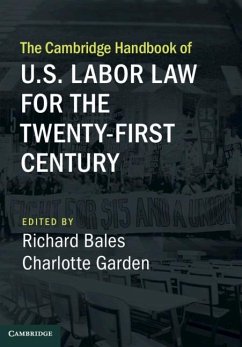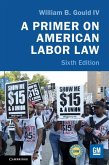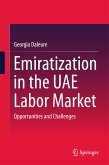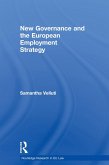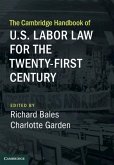Cambridge Handbook of U.S. Labor Law for the Twenty-First Century (eBook, PDF)
Redaktion: Bales, Richard


Alle Infos zum eBook verschenken

Cambridge Handbook of U.S. Labor Law for the Twenty-First Century (eBook, PDF)
Redaktion: Bales, Richard
- Format: PDF
- Merkliste
- Auf die Merkliste
- Bewerten Bewerten
- Teilen
- Produkt teilen
- Produkterinnerung
- Produkterinnerung

Hier können Sie sich einloggen

Bitte loggen Sie sich zunächst in Ihr Kundenkonto ein oder registrieren Sie sich bei bücher.de, um das eBook-Abo tolino select nutzen zu können.
Over the last fifty years in the United States, unions have been in deep decline, while income and wealth inequality have grown. In this timely work, editors Richard Bales and Charlotte Garden - with a roster of thirty-five leading labor scholars - analyze these trends and show how they are linked. Designed to appeal to those being introduced to the field as well as experts seeking new insights, this book demonstrates how federal labor law is failing today's workers and disempowering unions; how union jobs pay better than nonunion jobs and help to increase the wages of even nonunion workers;…mehr
- Geräte: PC
- mit Kopierschutz
- eBook Hilfe
- Größe: 4.47MB
- FamilySharing(5)
![Primer on American Labor Law (eBook, PDF) Primer on American Labor Law (eBook, PDF)]() William B. Gould IvPrimer on American Labor Law (eBook, PDF)29,95 €
William B. Gould IvPrimer on American Labor Law (eBook, PDF)29,95 €![Emiratization in the UAE Labor Market (eBook, PDF) Emiratization in the UAE Labor Market (eBook, PDF)]() Georgia DaleureEmiratization in the UAE Labor Market (eBook, PDF)48,95 €
Georgia DaleureEmiratization in the UAE Labor Market (eBook, PDF)48,95 €![New Governance and the European Employment Strategy (eBook, PDF) New Governance and the European Employment Strategy (eBook, PDF)]() Samantha VellutiNew Governance and the European Employment Strategy (eBook, PDF)30,95 €
Samantha VellutiNew Governance and the European Employment Strategy (eBook, PDF)30,95 €![Cambridge Handbook of U.S. Labor Law for the Twenty-First Century (eBook, ePUB) Cambridge Handbook of U.S. Labor Law for the Twenty-First Century (eBook, ePUB)]() Cambridge Handbook of U.S. Labor Law for the Twenty-First Century (eBook, ePUB)22,95 €
Cambridge Handbook of U.S. Labor Law for the Twenty-First Century (eBook, ePUB)22,95 €![International Labour Organization (ILO) (eBook, PDF) International Labour Organization (ILO) (eBook, PDF)]() Steve HughesInternational Labour Organization (ILO) (eBook, PDF)41,95 €
Steve HughesInternational Labour Organization (ILO) (eBook, PDF)41,95 €![Cambridge Handbook of Immunities and International Law (eBook, PDF) Cambridge Handbook of Immunities and International Law (eBook, PDF)]() Cambridge Handbook of Immunities and International Law (eBook, PDF)175,95 €
Cambridge Handbook of Immunities and International Law (eBook, PDF)175,95 €![Cambridge Companion to the International Court of Justice (eBook, PDF) Cambridge Companion to the International Court of Justice (eBook, PDF)]() Cambridge Companion to the International Court of Justice (eBook, PDF)31,95 €
Cambridge Companion to the International Court of Justice (eBook, PDF)31,95 €-
-
-
Dieser Download kann aus rechtlichen Gründen nur mit Rechnungsadresse in A, B, BG, CY, CZ, D, DK, EW, E, FIN, F, GR, HR, H, IRL, I, LT, L, LR, M, NL, PL, P, R, S, SLO, SK ausgeliefert werden.
- Produktdetails
- Verlag: Cambridge University Press
- Erscheinungstermin: 5. Dezember 2019
- Englisch
- ISBN-13: 9781108583251
- Artikelnr.: 66178472
- Verlag: Cambridge University Press
- Erscheinungstermin: 5. Dezember 2019
- Englisch
- ISBN-13: 9781108583251
- Artikelnr.: 66178472
- Herstellerkennzeichnung Die Herstellerinformationen sind derzeit nicht verfügbar.
Union trends Richard Bales; 2. The consequences of union decline Jake
Rosenfeld; Part II. Labor Law Is Out of Date: 3. Yesterday's labor law and
today's challenges Cynthia Estlund; 4. The National Labor Relations Board
in the twenty-first century William B. Gould, IV; 5. Beyond the race to the
bottom: reforming labor law preemption to allow state experimentation
Charlotte Garden; 6. Union rights for all: towards sectoral bargaining in
the United States Kate Andrias; 7. Public sector innovations: valuing voice
Ann C. Hodges and Martin H. Malin; 8. Combatting union monopoly power: the
contrast between pre- and post-new deal legal regimes Richard A. Epstein;
9. The case for repealing the firm exemption to antitrust (a modest
proposal; or, a response to Professor Epstein) Sanjukta Paul; 10. Make
labor organizing a civil right Richard Kahlenberg and Moshe Marvit; Part
III. The 'Fissured' Workplace: 11. Some problems with NLRA coverage:
independent contractors and joint employers Joseph Slater; 12. Reinventing
employers Jeffrey Hirsch; 13. The problem of 'misclassification' or how to
define who is an 'employee' under protective legislation in the information
age Kenneth G. Dau-Schmidt; 14. Rupture and invention: the changing nature
of work and the implications for social policy Katherine V. W. Stone; 15.
Contemplating new categories of workers: technology and the fissured
workplace Miriam A. Cherry; 16. Balancing flexibility and rigidity: do
unions make sense in the on-demand economy? Seth Oranburg and Liya
Palagashvili; Part IV. Barriers to Forming a Collective Bargaining
Relationship: 17. Tactical mismatch in union organizing drives Charlotte
Garden; 18. The power of place Michael M. Oswalt; 19. Assembly and
collective rights Marion Crain; 20. Leveraging secondary activity within
and outside legal boundaries Anne Marie Lofaso; 21. Captive audience
meetings: the right not to attend Paul M. Secunda; Part V. Barriers to
Bargaining a Good Contract: 22. Obtaining a first contract after winning
recognition David Rosenfeld; 23. Advancing global labor standards:
potential and limits of international labor law for worker-rights advocacy
in the United States Lance Compa; 24. Organizing for workplace rights when
immigration law discourages it Leticia M. Saucedo; 25. The central role of
the right to strike Julius Getman; 26. Organizational power for workers
within the firm Matthew T. Bodie; 27. Returning members-only collective
bargaining to the American workplace: how to restore labor's countervailing
power Charles J. Morris: Part VI. Unions, Civil Society, and Culture: 28.
Can labor law reform encourage robust economic democracy? Brishen Rogers;
29. Union security for the twenty-first century Catherine L. Fisk; 30.
Union membership and the Ghent system Matthew Dimick; 31. Principled hope:
labor law reform from an alt-labor perspective Cesar F. Rosado Marzan; 32.
Politically engaged unionism: the culinary workers union in Las Vegas Ruben
J. Garcia; 33. Union commitment to racial diversity Michael Z. Green; 34.
The economics of minimum wage regulations Jesus Fernandez-Villaverde; 35.
The role of labor research and education in the labor movement of the
twenty-first century: the UCLA Labor Center and the CLEAN Carwash Campaign
Victor Narro; Index.
Union trends Richard Bales; 2. The consequences of union decline Jake
Rosenfeld; Part II. Labor Law Is Out of Date: 3. Yesterday's labor law and
today's challenges Cynthia Estlund; 4. The National Labor Relations Board
in the twenty-first century William B. Gould, IV; 5. Beyond the race to the
bottom: reforming labor law preemption to allow state experimentation
Charlotte Garden; 6. Union rights for all: towards sectoral bargaining in
the United States Kate Andrias; 7. Public sector innovations: valuing voice
Ann C. Hodges and Martin H. Malin; 8. Combatting union monopoly power: the
contrast between pre- and post-new deal legal regimes Richard A. Epstein;
9. The case for repealing the firm exemption to antitrust (a modest
proposal; or, a response to Professor Epstein) Sanjukta Paul; 10. Make
labor organizing a civil right Richard Kahlenberg and Moshe Marvit; Part
III. The 'Fissured' Workplace: 11. Some problems with NLRA coverage:
independent contractors and joint employers Joseph Slater; 12. Reinventing
employers Jeffrey Hirsch; 13. The problem of 'misclassification' or how to
define who is an 'employee' under protective legislation in the information
age Kenneth G. Dau-Schmidt; 14. Rupture and invention: the changing nature
of work and the implications for social policy Katherine V. W. Stone; 15.
Contemplating new categories of workers: technology and the fissured
workplace Miriam A. Cherry; 16. Balancing flexibility and rigidity: do
unions make sense in the on-demand economy? Seth Oranburg and Liya
Palagashvili; Part IV. Barriers to Forming a Collective Bargaining
Relationship: 17. Tactical mismatch in union organizing drives Charlotte
Garden; 18. The power of place Michael M. Oswalt; 19. Assembly and
collective rights Marion Crain; 20. Leveraging secondary activity within
and outside legal boundaries Anne Marie Lofaso; 21. Captive audience
meetings: the right not to attend Paul M. Secunda; Part V. Barriers to
Bargaining a Good Contract: 22. Obtaining a first contract after winning
recognition David Rosenfeld; 23. Advancing global labor standards:
potential and limits of international labor law for worker-rights advocacy
in the United States Lance Compa; 24. Organizing for workplace rights when
immigration law discourages it Leticia M. Saucedo; 25. The central role of
the right to strike Julius Getman; 26. Organizational power for workers
within the firm Matthew T. Bodie; 27. Returning members-only collective
bargaining to the American workplace: how to restore labor's countervailing
power Charles J. Morris: Part VI. Unions, Civil Society, and Culture: 28.
Can labor law reform encourage robust economic democracy? Brishen Rogers;
29. Union security for the twenty-first century Catherine L. Fisk; 30.
Union membership and the Ghent system Matthew Dimick; 31. Principled hope:
labor law reform from an alt-labor perspective Cesar F. Rosado Marzan; 32.
Politically engaged unionism: the culinary workers union in Las Vegas Ruben
J. Garcia; 33. Union commitment to racial diversity Michael Z. Green; 34.
The economics of minimum wage regulations Jesus Fernandez-Villaverde; 35.
The role of labor research and education in the labor movement of the
twenty-first century: the UCLA Labor Center and the CLEAN Carwash Campaign
Victor Narro; Index.
